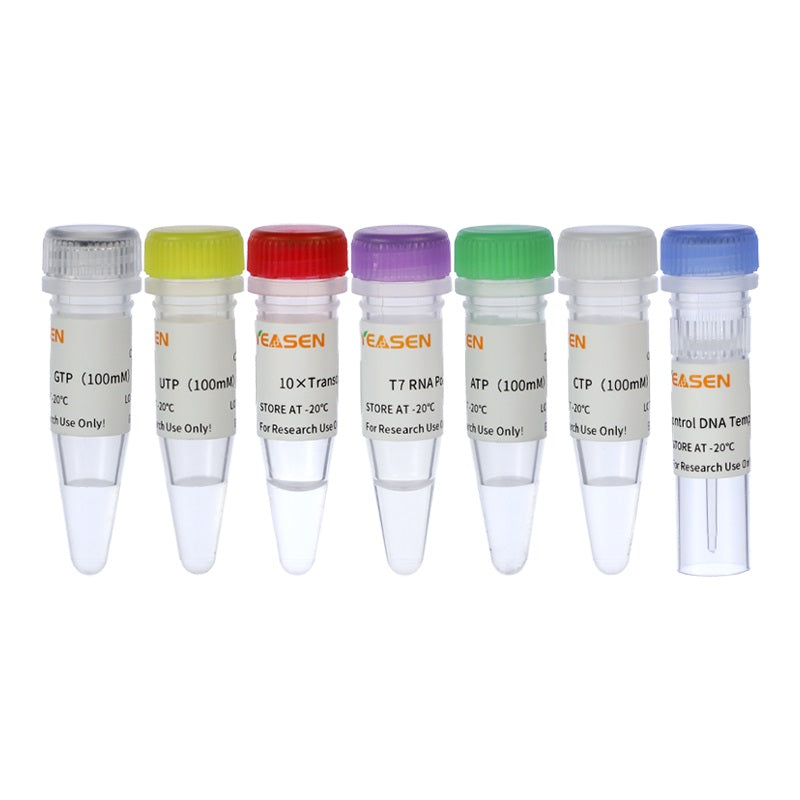Description
The kit utilizes T7 RNA Polymerase (Low dsRNA) and high-affinity LZcap AG Cap1 analog to produce mRNAs with significantly reduced double-stranded RNA (dsRNA) content and enhanced expression. Single-stranded RNAs are synthesized using linear double-stranded DNA containing a T7 promoter sequence as the template. Modified nucleotides, such as biotin or dye-labeled nucleotides, can be incorporated during transcription to generate labeled RNA. The kit supports the synthesis of both long and short transcripts, yielding 100–200 μg of RNA from 1 μg of DNA template. Substituting UTP with N1-Me-Pseudo UTP reduces RNA immunogenicity. The resulting RNA is suitable for downstream applications, including RNA structure and function studies, RNase protection, probe hybridization, RNAi, microinjection, and in vitro translation.
Components
|
Components No. |
Name |
10635ES10 (10 T) |
10635ES50 (50 T) |
10635ES60 (100 T) |
10635ES70 (500 T) |
|
10635-A |
T7 RNA Polymerase Mix |
20 μL |
100 μL |
200 μL |
1 mL |
|
10635-B |
10×Transcription Buffer |
20 μL |
100 μL |
200 μL |
1 mL |
|
10635-C |
ATP(100mM) |
20 μL |
100 μL |
200 μL |
1 mL |
|
10635-D |
CTP(100mM) |
20 μL |
100 μL |
200 μL |
1 mL |
|
10635-E |
GTP(100mM) |
20 μL |
100 μL |
200 μL |
1 mL |
|
10635-F |
N1-Me-Pseudo UTP(100mM) |
20 μL |
100 μL |
200 μL |
1 mL |
|
10635-G |
Control DNA Template(500ng/μL) |
5 μL |
10 μL |
20 μL |
100 μL |
|
10635-H |
DNase I (2 U/μL) |
10 μL |
50 μL |
100 μL |
500 μL |
|
10635-I |
Cap1 Analog (100 mM) |
20 μL |
100 μL |
200 μL |
1 mL |
|
10635-J |
Lithium chloride solution |
300 μL |
1.5 mL |
3 mL |
15 mL |
|
10635-K |
RNase-free ddH2O |
500 μL |
2.5 mL |
5 mL |
25 mL |
Note: The T7 RNA Polymerase Mix includes T7 RNA polymerase (Low dsRNA, Cat: 10628), Murine RNase inhibitor (Cat: 10621) and Pyrophosphatase Inorganic (Cat: 10620); The Cap1 Analog is LZcap AG (Cat: 10684). The catalog number of recommended UTP and Pseudo UTP is 10654 and 10656, respectively.
Features
- Complete Kit Components: Includes all essential reagents for one-step co-transcriptional capping, such as NTPs, T7 Enzyme Mix, cap analog, DNase I, and LiCl.
- Simplified Workflow: Utilizes a co-transcriptional capping process, minimizing the number of components introduced and streamlining the overall procedure for ease of use.
- High Yield: Generates 150–200 µg of Cap 1 mRNA from just 1 µg of DNA template.
- Reduced Immunogenicity: Incorporates modified N1-Me-pUTP and a low dsRNA T7 RNA polymerase to minimize unintended innate immune responses.
- High Capping Efficiency: Achieves capping efficiency exceeding 99%.
Figure
1. Broad Applicability:
Consistently delivers a high yield of 9 mg/mL with capping efficiency up to 100% in a 20 µL reaction system using 1 µg of plasmid DNA, regardless of the length of the target transcript.
|
mRNA Category |
Yield(mg/mL) |
mRNA Integrity(%) |
Capping Efficiency(%) |
|
eGFP |
11.2 |
93.5 |
100% |
|
OVA |
10.2 |
94.3 |
100% |
|
mcherry |
9.1 |
90.3 |
100% |
|
Luciferase |
9.3 |
90.1 |
100% |
|
Cas 9 |
9 |
88.7 |
100% |
Table 1. Broad applicability of the Co-transcription system
|
|
Cap analog |
Cap Concn. (mM) |
Yields (mg/mL) |
Integrity (%) |
Capping efficiency by MS (%) |
|
1 |
Cap AG (3'OMe-7mG) |
10 |
12.69 |
80.6 |
100 |
|
2 |
LZCap AG |
10 |
12.11 |
82.8 |
100 |
|
3 |
LZCap AG |
7.5 |
11.59 |
82.2 |
100 |
|
4 |
LZCap AG |
5 |
11.16 |
81.6 |
100 |
|
5 |
LZCap AG |
2.5 |
10.75 |
81.4 |
100 |

Figure 1. Co-transcription analysis of the input of LZcap AG. IVT materials include Hieff™ T7 RNA Polymerase, Template: Cas9 (4K); T7 Reaction Buffer 2; Tris NTP (including N1-Me-Pseudo UTP Tris Solution). IVT time: 3 hrs.
|
Fragment Length |
T7 RNA pol |
Yield (mg/mL) |
Integrity (%) |
dsRNA Content (ng/ug of RNA) |
|
4K mRNA |
Regular T7 Kit |
12.4 |
88.3 |
0.4273 |
|
Low dsRNA T7 Kit |
12.1 |
89.9 |
0.0129 |
|
|
9K mRNA |
Regular T7 Kit |
9.5 |
81.9 |
2.9180 |
|
Low dsRNA T7 Kit |
9.0 |
82.0 |
0.0379 |
Table 2. dsRNA content analysis of regular T7 Kit and Low dsRNA T7 Kit.
Storage
This product should be stored at -25 ~-15℃ for one year.
Notes:
1. Be careful not to mix RNase in the reaction system.
2. Experiment equipment (such as: pipette tip, product tube, etc.) should strictly use RNase-free products.
3. For your safety and health, please wear lab coats and disposable gloves.
4. For research use only!
Document
Safety Data Sheet
10635_MSDS
Manual
Payment & Security
Your payment information is processed securely. We do not store credit card details nor have access to your credit card information.
Inquiry
You may also like
FAQ
The product is for research purposes only and is not intended for therapeutic or diagnostic use in humans or animals. Products and content are protected by patents, trademarks, and copyrights owned by Yeasen Biotechnology. Trademark symbols indicate the country of origin, not necessarily registration in all regions.
Certain applications may require additional third-party intellectual property rights.
Yeasen is dedicated to ethical science, believing our research should address critical questions while ensuring safety and ethical standards.

